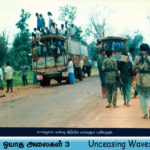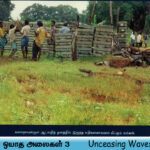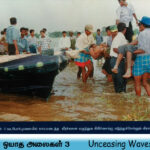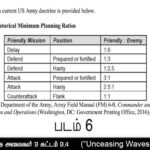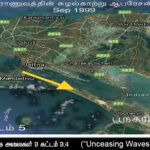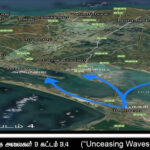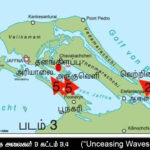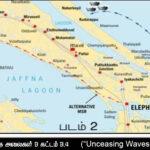

“Unceasing Waves 3” Warfare Study – Article 1

LTTE’s ”Oyaatha Alaihal 3” (“Unceasing Waves 3”)
Warfare Study – Article 1
One of the compelling events in the history of world warfare is the operation by LTTE: “Unceasing Waves 3” on the Elephant Pass area in 1999-2000. The purpose of this post is to explain why this battle is one of the most important events in the history of world warfare.
I have divided this record into 3 parts.
In Part 1 I have given a very brief description of the war situation before the LTTE launched the “Unceasing Waves 3”. During that four-month period from December 1999 to April 2000, during which the LTTE’s “Unceasing Waves 3” (Phase 3, Phase 4) took place, I have mapped out only the most important borehole movements of the LTTE, chronologically stacking those major movements as arrows in Part 2.
It is very difficult to cover all the war moves that took place during this four-month period. As well as the record is very lengthy. That is why I have only mentioned the most important moves. In Part 3 I have given an approach to the LTTE’s war moves given in Part 2 through the perspective of the study of war.
In this post I am only taking Phase 3, Phase 4 of the LTTE’s “Unceasing Waves 3” for analysis. I have used this phrase briefly in English as it has to be used throughout the record. I have shortened “Unceasing Waves 3” (Phase 3, Phase 4) (UW3 -P3, P4) as the English translation of “Unceasing Waves 3”.
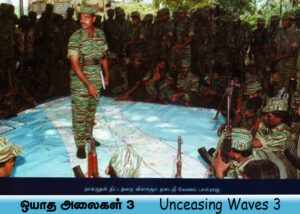
Part 1
Observing the terrain of Sri Lanka, it is clear that Jaffna (head area) and the rest of Sri Lanka (body part) are tucked away through a small area (neck area). At that neck was the Elephant Pass.
Jaffna is divided into three parts: Valikamam, Vadamaradchi and Thenmaradchi. (Figure 3) As the LTTE began to convert its battalions into conventional warring forces during the Second Eelam War (1990-1994), the military concentration of the Elephant Pass began to increase.
After the LTTE began to become a conventional warfare, the military-centric importance of the area began to increase as the neck area became essential for the easy transfer of their battalions and heavy weapons to Vanni and Jaffna Bay.
Thus, Elephant Pass, which was a mere military camp before 1991, was later transformed into Elephant Pass. In 1995, the Sri Lankan army captured the Jaffna area.
In 1999, the LTTE captured the neck area and the Sri Lankan military’s maritime and air supply route. They decided to cut off and lay barricade to the entire army of Jaffna.
Part 2
- “Unceasing Waves 3” Phase 3, launched on 10/12/1999
12/12/1999 – The LTTE attacked the Kattikadu Army camp and took control of the area.
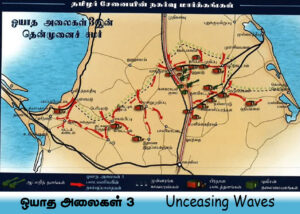
The LTTE then attacked and captured the Army Navy Base in the northeastern part of the Jaffna Peninsula.
(Image 1: Number 2)
The area where the Vetrilaikkeni Naval Base was located, which also patrolled the northeastern seas of Jaffna, was of military importance.
The Pullaveli Army Camp on the west side of the Jaffna area was also attacked and captured.
The Malathy Brigade captured the Mulliyan Camp, which was the base of the second Gemunu Battalion.
The Malathy Brigade and the Jaffna Brigade advanced further from Mulliyan, Mandalay.
About 150 soldiers were killed in these attacks. The LTTE claimed 38 freedom fighters were killed on its side.
Another warhead opened.
On 12/12/1999 at ten o’clock in the morning two separate divisions in Ariyalai and Arukuveli was opened.
A contingent of Malathy Brigade, Jeyanthan Brigade and Imran Pandian Brigade was deployed at Keratheevu and Arukuveli, south of Chavakachcheri.
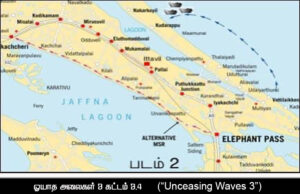
Arukuveli camp was captured. Similarly, the Keratheevu naval base was attacked and a large quantity of weapons and radar were captured by the LTTE. They brought those areas under their control by the evening of that day.
(Image 1: Number 5)
13/12/1999 – Attacked and captured a mini camp in Aliyavalai area to ensure the security of the area.
16/12/1999 – The coastal areas between Chundikulam and Maruthangeni were brought under LTTE control. This enabled the LTTE to move its heavy weapons to Jaffna.
On the next move, a LTTE battalion infiltrated the Tanangilapu area.
Jaffna is a few km away from Thanangilapu.
Paranthan Base
The Paranthan army camp is situated strategically on the southern sector of the Elephant Pass base complex. Commander Theepan has been appointed to launch an attack on the Sri Lanka Army’s 6th Division’s Brigade Base and the 54th Division’s 5th Brigade’s Umayalpuram Base.
16/12/1999 – The LTTE launches an attack on a large base. Leading forces in the attack were the Charles Anthony Brigade and the Malathy Brigade.
19/12/1999 – The base of the 54-6th Brigade was captured through a bipolar move.
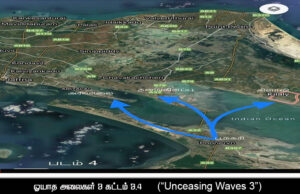
Meanwhile the Sri Lanka Air Force MI 24 helicopter was shot down by LTTE.
21/12/1999 – The Paranthan chemical factory camp and the Korakkankattu Kulam army camp were attacked and captured by the LTTE.
(Image 1: Number 6)
The LTTE has informed the people living in the areas of the Maruthangeni and Thalayadi army camps to move to safer places by 25/12/99.
Umayalpuram army base fell. 27/12/1999 – The Umayalpuram base of the 54-5th Brigade, 5 km south of the Elephant Pass base, was captured by the LTTE.
The 54-6th Brigade of the Sri Lankan Army, which had retreated after the loss of the Paranthan base, had set up a strong defensive line along with the 54-5th Brigade at Umayalpuram.
The LTTE also captured 40 mini camps around Umayalpuram.
The LTTE claimed that 39 freedom fighters were killed on its side in the two-day battle to capture the Umayalpuram military base. 30/12/1999 – Sri Lanka Air Force Kibir fighter jets and helicopters carry out heavy bombardment of LTTE positions in Poonakary and Keratheevu areas.
02/02/2000 – Clashes broke out between the LTTE and the Sri Lankan Army in the Thanangilapu and Keratheevu areas.
18/2/2000 – Sri Lanka Air Force Bell Helicopter shot down by LTTE in Thenmaradchi area.
12/3/2000 – Sri Lankan Army commando operation to retake LTTE-held Uduthurai fails.
The famous Kudarappu Battle
26/3/2000 – The day of the LTTE’s historic sea borne invasion. (Image 1: Blue Arrow)
After landing, the LTTE launched their major offensive at around 9pm. Simultaneously the army camps at Thalayadi, Sembianpatru and Maruthangeni were attacked. (Image 1: Number 7)
Commando attack on Pallai Military Base, which was an artillery base
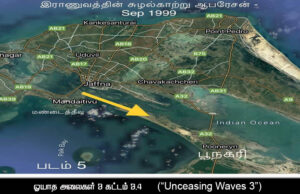
On the other hand, LTTE commandos launched an offensive on the Pallai Army Base on A9 Kandy Road. In this attack, 11 artillery pieces of the Sri Lankan Army and its arsenal were destroyed.
(Figure 1: No. 8)
As the cannons in the barracks were annihilated, its fire power was greatly reduced. As well as an attack on the operating military base, the LTTE launched heavy artillery and mortar attacks on the LTTE stronghold.
Main Supply Route disconnection
The LTTE cut off the A9 Kandy Road, which was the main supply route (MSR) for the Elephant Pass and Operational Army Base.
This forced the Sri Lankan military to use the Alternative Supply Route on the Black Sea Island, a narrow passage through the Bhopal. This alternative route was not suitable for moving heavy weapons or vehicles. (Figure 2)
The breach in the MSR between Jaffna and the Iyakachchi-Elephant Pass sector has caused logistical problems for the army in sending in reinforcements and evacuating the wounded from the battle zones in the southern part of the Thenmaradchi division, military sources in the north said.
28/03/2000 – LTTE captures Mamunai Army Camp.
The military complex fell under the sheet.
29/03/2000 – After three days of heavy fighting, the LTTE attacked and captured the military base under Thalai.
Based on this underground military base
Thalayadi-Maruthangeni-Sembianpatru camps are an integrated army complex. The length of the security levels at this site is about 14 km. The largest and the well-fortified military base in the eastern coastal belt of Vadamaradchi.
The base was controlled by the 53rd Division, which was considered the best brigade in the Sri Lankan Army.
The 53 Division is the Sri Lankan army’s best fighting arm, comprising Special Forces, an air mobile brigade, a mechanized infantry unit etc. The Division receives US Special Forces training and advice.
Meanwhile, LTTE Special Forces destroyed 11 artillery guns at the Tambuthottam Army Camp and 4 artillery shells at the Tamaraikulam Army Camp.
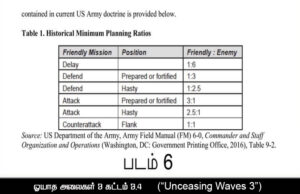
Occurred on the other side of the surface.
Meanwhile, an LTTE battalion that infiltrated in December 1999 continued to control the southern part of Chavakachcheri, Tanangilapu and Keratheevu.
During these three months, the Sri Lankan military has been unable to dislodge the LTTE, which has been trying to inflict heavy airstrikes, artillery fire and military attacks in the area.
The LTTE’s continued retention of these areas was a significant move in the war strategy.
In the War Analysis paragraph, I will describe what is of great importance.
The Sri Lankan Army fought to restore the main supply route
02/04/2000 – The LTTE has taken control of a 4km stretch of the A9, the main supply route to Elephant Pass, the main route to the mainland.
The Sri Lankan military launched Operation Wali Sakara to recapture the “small area”. The Sri Lankan army advanced on its armored unit, moving on two fronts.
The LTTE launched a counter-attack in the Muhamalai area. During this fierce battle, 2 Main Battle Tanks (MBT) of the Sri Lankan Army were completely destroyed by the LTTE. And 5 tanks (MBT) were severely damaged.
The LTTE also captured 2 South African ‘Buffel’ armored vehicles. More than 100 Sri Lankan soldiers were killed in the LTTE’s counter-attack. More than three hundred soldiers were wounded.
In the last five days since March 27, Operation Wali Chakra has been the third major offensive by the Sri Lankan military to capture the area.
04/4/2000 – The Sri Lankan Army resumes a new military operation. The name of this operation is’ Operation ‘Welikathara’.
The LTTE thwarted the Sri Lankan Army’s operation towards Muhamalai by launching a counter-attack. In the aftermath of the counter-attack, the LTTE found 60 bodies of Sri Lankan soldiers in their area alone.
10/4/2000 – The Sri Lankan Army launches a new offensive with a multi-pronged move to recapture the LTTE’s small area.
Four Sri Lankan Army tanks (MBTs) were completely destroyed in the LTTE counter-attack. And 5 tanks (MBT) were damaged.
LTTE Final Push
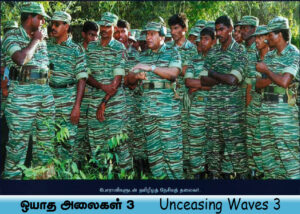
18/04/2000 The LTTE launched the final major offensive to achieve the goal of “Unceasing Waves 3”. In this attack, the movement took complete control of the military camps surrounding the military base. In particular, the Soranpatru and Masar army camps fell.
(Image 1: Number 10)
Several well-entrenched military bases that formed the buffer zone of the Iyakachchi-Elephant Pass area complex collapsed during the intense fighting.
After this massive attack, only the operating army base and the Elephant Pass base remained. The Main Supply Route (MSR) for the two bases had already been completely cut off, and the security camps for them had been completely destroyed following the attack.
With the fall of several well fortified military bases in its proximity and the A9 highway cut-off at two strategic locations, the Iyakachchi-Elephant Pass base complex is facing a serious threat. Territorially isolated, supply lines cut-off and surrounded by powerful combat formations of the LTTE on all sides, a division of Sri Lankan troops occupying the complex is in serious crisis.
20/04/2000 – LTTE launches multi-pronged attack on operating military base.
22/04/2000 – Elephant Passes Fallen.
During the attack, LTTE commandos destroyed artillery, tanks, armored vehicles and armories in the operational camp.
The operational military base collapsed after two days of heavy LTTE aggression.
The LTTE launched a multi-pronged attack on the Elephant Pass base shortly after the fall of the LTTE base. The Elephant Pass also collapsed in the attack.
More than a thousand Sri Lankan soldiers were killed in the LTTE’s final offensive on the Elephant Pass base alone.
The LTTE captured 152 mm artillery, tanks and armored vehicles from the two bases.
Part 3 – “Unceasing Waves 3” (Phase 3, Phase 4) through War Study View
How did the LTTE recapture the Elephant Pass, or more precisely the collective base, a set of military bases covering several hundred square kilometers?
Why do I call this a collection of military highlights in the first place?
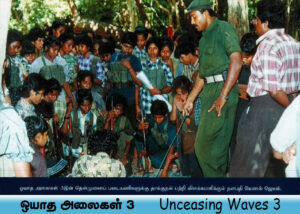
The guard length of the two major sites, Iyakachchi and Elephant Pass, is only 76 km. Its area is 259 sq. km.
These include the Pallai Army Base, a base with a large number of artillery, the Army Special Base Commando’s 53rd Division Army Base, the Army and Naval Base Vetrilaikkeni Base, two large bases on the south side, Paranthan and Umayalpuram, followed by several military bases. It was a collection of hundreds of mini-military bases that were fortified as a bulwark against all of this.
It was because of such supreme security that even a few months before the attack, a US commander visited the Elephant Pass high ground military zone and said it was impregnable. It is not an exaggerated claim.
So how did the LTTE recover this set of military bases?
The answer to this can only be found by examining the war view. The operation “Unceasing Waves 3” that toppled the set of Elephant Army Bases depend on the war method; Maneuver Warfare.
What is this Maneuver Warfare strategy?
This was written by Major Kevin P. Clemons, an army commander, to explain the war technique. The name of the book is: Maneuver Warfare: Can Modern Military Strategy Lead You to Victory?
I have also taken the article for occasional quotes in this post.
Maneuver Warfare represents — in the words of the United States Marine Corps doctrinal manual, Warfighting— “a state of mind bent on shattering the enemy morally and physically by paralyzing and confounding him, by avoiding his strength, by quickly and aggressively exploiting his vulnerabilities, and by striking him in a way that will hurt him most.”
Its ultimate aim is not to destroy the adversary’s forces but to render them unable to fight as an effective, coordinated whole.
In short, troop strength, firepower, weapons technology and logistics are the most important factors in determining the outcome of a war. When these factors are in favor of the enemy, it can be said that Maneuver Warfare is about avoiding the strong factors of that strong enemy, attacking the weak sides accurately and causing great destruction, shocking their decision making ability and paralyzing their fighting ability.
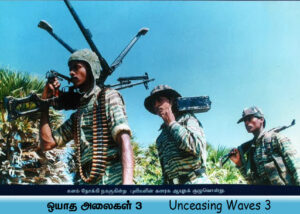
Maneuver Warfare is a military strategy, which attempts to defeat the enemy by incapacitating their decision making through shock and disruption. However, this brief explanation is not a complete explanation in a sense.
So I tend to explain this war technique through some questions.
First, why does Maneuver Warfare require boring strategy?
Let us look at the force situation during the period 1999-2000 when there were “Unceasing Waves 3”.
The total strength of the Sri Lankan Army is at least 150000.
The maximum number of LTTE cadres is 14000.
Force Ratio (1:10) according to this calculation.
That means there are at least 10 Sri Lankan armies against every LTTE fighter.
Taken as firepower and weapons technology, the LTTE, as a non-state actor, cannot afford the heavy weapons or technology equivalent of a sovereign state. Unless another sovereign state helps.
For example, the number of artillery held by the LTTE before the “Unceasing Waves 3” was only three. The Sri Lankan army in the Holocaust used all three artillery units.
Two 122 mm howitzers were captured from the Mullaitheevu Military Base in 1996, and the other captured and at Pulukkunawa Camp the same year.
In addition, if you look at the shells as 120 mm mortars, their number is less than 10. These are the LTTE’s long-range heavy-duty firearms. The Sri Lankan Military, on the other hand, is equipped with its Main Battle Tank (MBT), multiple artillery pieces, and bombers. In conventional warfare, heavy weapons, their numbers, and their firepower play a vital role.
The LTTE now has a small number of heavy weapons that they cannot afford, the Sri Lankan military’s heavy. Stopping weapons “directly” and waging conventional warfare will only lead to their loss.
Similarly, when the Force Ratio is against the LTTE (10: 1), the LTTE will be less in number and more offensive in offensive-based conventional warfare against the stronger Sri Lankan Army. Because that is the nature of conventional warfare. The side with the most resources has the best chance to win.
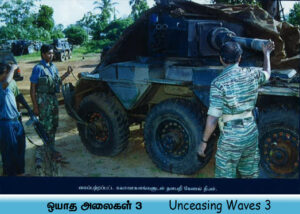
Thus in conventional warfare there is a war name for the strategy of fighting in an “opposite” approach. I will explain it later in this post. Maneuver Warfare is therefore the act of wreaking havoc on the enemy by moving their troop strength, weapons, and firepower to maximize use of the relatively limited resources of the opposing faction.
Therefore, Maneuver Warfare is a harder war method than the “opposite” approach.
“Unceasing Waves 3” and its Maneuver Warfare characteristics
In this paragraph, I will give below the main characteristics of maneuver warfare strategy and what movements they were in “Unceasing Waves”.
Targeting Critical Vulnerabilities
A practitioner of maneuver warfare constantly analyzes a rival with the aim of discovering those fundamental weaknesses that, “if exploited, will do the most significant damage to the enemy’s ability to resist.” Accurately locating the enemy’s lifeline is the most important characteristic of maneuver warfare.
If the “Unceasing Waves 3” Elephant Pass takes 3 fights, you can see that the Elephant Pass had strong plateaus around itself for its protective layer.
However, the main supply route (MSR) of the Elephant Pass was the A9 main route and the Betelcoat Naval Base by sea. These two supply routes are the lifeblood of the Elephant Pass. The national leader Prabhakaran knew that the Elephant Pass would fall automatically if these supply lines were cut off.
That is why he designed the focal point for the “Unceasing Waves 3” (UW -P3, P4) to intercept these supply lines (MSR).
Accordingly, the first target of UW3 (P3, P4) was to capture the pawn. Thereby cutting off a supply route.
It is noteworthy that during the LTTE siege of Elephant Pass in 1991, the Sri Lankan Army landed its reinforcements and broke the LTTE siege under the same pretext.
The second MSR aimed to cut off the A9 – the next four months were spent fighting “Unceasing Waves 3” (UW3 – P3, P4).
Bypassing and cutting off enemy strongpoints often results in the collapse of that strongpoint even where the physical damage is minimal, such as the MAGINOT LINE.
This is exactly what the LTTE did. It was not until 20/04/2000 that their infantry forces launched a frontal attack on the very strong Elephant Pass and Movement platform.
Only occasional concentrated artillery fire was used to soften their enemy positions (softening enemy positions with artillery bombardment).
This can be understood from another angle. Avoid Strength, Attack Weakness can also be taken as the Chinese war scholar “Sun Tzu” stated in his “Art of War”.
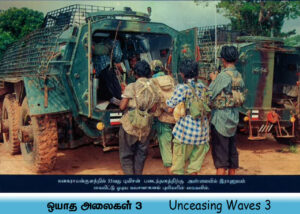
In maneuver warfare, the destruction of certain enemy targets, such as command and control centers, logistical bases or fire support assets, is combined with isolation of enemy forces and the exploitation by movement of enemy weaknesses.
Weaken the main target by destroying specific enemy positions, command and control (C2), logistical bases, or hot support levels.
On 26/03/2000, the LTTE Commando Brigade launched an offensive on the Pallai Army Camp. In this attack, 11 artillery pieces of the Sri Lankan Army and its arsenal were destroyed. (Special commando units of the LTTE stormed the military garrison at Pallai and destroyed the main artillery base and ammunition dump. Explosives destroyed eleven heavy artillery pieces.)
By destroying the artillery of the Pallai plateau, the level of heat support from the Elephant plateau was greatly weakened. (Figure-1: No. 8)
Next up is – Surprise.
Striking a foe in an unexpected manner can disorient him and ensure that his response comes too late to be effective.
Surprise can be achieved by using one of three approaches: stealth, ambiguity, or deception.
Deception, “to convince the enemy that we are going to do something other than what we are really going to do,” is designed to cause a rival to deploy resources erroneously.
By a boring move, the enemy incorrectly absorbs the character of the battlefield.
When the enemy inadvertently enters the battlefield, the enemy’s response to the bore move will also be erroneous. This requires Deception.
On 12/12/1999, the national leader Prabhakaran made such a deception by landing the LTTE in two separate divisions in and around the eastern Ariyalai area. This is the war tip that opens in a completely different direction.
The LTTE landed and captured the nearby camp. Similarly, the Karatheevu Naval Base was attacked and a large quantity of weapons and radar were seized by the LTTE. They brought those areas under their control by the evening of that day. (Figure 2)
However, surprisingly, while many have posted about the “Unceasing Waves 3” so far, no one has mentioned the battle that unfolded at this other end.
However, this unnamed battlefield is one of the most important of the “Unceasing Waves 3” (UW3 – P3, P4) that I came to understand through my war study.
Why is this fight that opened at the other end so important?
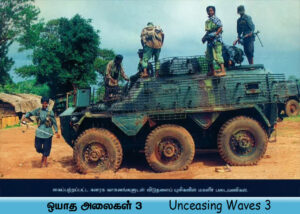
During the period 1999-2000, there were three divisions of the Sri Lanka Army in Jaffna. One division has 10000-15000 troops.
Elephant Pass and the surrounding plains were under the control of the 54th Division. The sheet pile surrounding it was in the possession of the 53rd Division. Valikamam areas were under the control of the 52nd Division. According to various sources, there were at least 40,000 soldiers in Jaffna that day.
That means there were at least 40,000 soldiers in the theater of war in Jaffna. (In warfare, a theater is an area in which important military events occur or are progressing.)
Apart from this, other divisions of the Sri Lankan Army were stationed in other theaters on the battlefield. As mentioned above, the total number of soldiers in the Sri Lankan Army was at least 150,000.
However, the total number of LTTE cadres is a maximum of 14,000 fighters. Not all fighters can be assigned as “Oyaatha Alaihal – 3”.
The reason is that in other theaters, the remaining divisions of the Sri Lankan army are moving towards the LTTE’s new positions. To prevent such moves, a significant LTTE battalion would be stationed at other theaters ready for defensive warfare.
The number of fighters deployed to fight the “Unceasing Waves 3” (UW3 -P3, P4) is unknown to date.
According to this estimate, the Sri Lankan military has at least 40,000 troops in Jaffna.
The maximum number of deploy fighters against the army is unlikely to exceed 7,000. Nevertheless, I guess a smaller number of fighters would have been moved than this. However, the reason for taking the maximum number, as 7000 is to make you understand the deception war move of the national leader Prabhakaran.
By landing the LTTE on 12/12/1999 in two separate divisions in and around East Ariyalai, the LTTE created the engineering move to seek to capture Jaffna. (Figure-1: No. 5)
Now the Sri Lankan army is in a dilemma as to whether to consolidate the LTTE’s moves along the northern coast (Figure-1: Nos. 1, 2, 3, 7) or to stop the eastern Aryan, adjacent movements (Figure-1: No. 5).
The reason is that Ariyalai is a few km away from Jaffna.
If the LTTE makes a seaborne invasion from Poonakary to the eastern Ariyalai, Tanangilapu coast, the Sri Lankan military will be forced to keep its troops in Valikamam.
(Image-3), (Image-4)
Thus, to stop the LTTE’s 40,000 Sri Lankan Army presence in Jaffna from advancing towards the LTTE’s North Coast (Figure-1: Nos. 1, 2, 3, 7);
The Sri Lankan Military was forced to split the eastern Ariayalai into two (Figure-1: No. 5) to prevent movement in the Thanangilapu area.
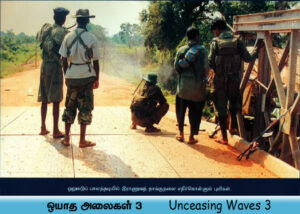
When the Sri Lankan Army split its 40,000 troops into two to block the LTTE’s two fronts, it was able to deploy less than 25,000 troops for moves along the northern coast (Figure 1: Nos. 1, 2, 3, 7).
Although the exact number of Sri Lankan troops assigned to the theater is unknown, it is safe to assume that the number of Sri Lankan troops assigned to the theater was between 17000-25000.
The Liberation Tigers currently hold a beach head extending to about six kilometers on either side of the road from the Keratheevu jetty, south of Chavakachcheri, to the Thanangilapu junction. (This road turns north from this junction to Chavakachcheri town and west to the village of Thanangilapu)
The army has been unable to dislodge the LTTE from this sector despite more than three months of concerted air and artillery attacks. The LTTE troops operating in this beach head run vehicles too.
The Sri Lankan Army claims that neutralizing the power of the Sea Tigers in the Jaffna lagoon is important at this juncture to prevent the LTTE from launching any major thrust into the peninsula from the Keratheevu – Thanangilapu beach head as this would bring them close to the Jaffna’s town’s entrance .
Sri Lankan Army planners are also apprehensive that the Sea Tigers may embark on a major amphibious offensive on Kilaly or a tactically suitable point on the Thenmaradchi division’s coast with the Jaffna lagoon in the next phase of Operation “Unceasing Waves 3”.
That the national leader Prabhakaran established this type of open Deception in the Thanangilapu area has greatly changed the military balance of the Vadamaradchi coastal area. I will now return to the above information.
Now face 7000 LTTE.
The number of Sri Lankan troops required has been reduced to less than 25,000.
At the same time, it should be noted that four months after the LTTE battalion landed in the Eastern Ariyalai Tanangilapu area in December 1999, heavy airstrikes and artillery attacks by the Sri Lankan army thwarted the army’s advance efforts.
I would like to give further information to prove that this eastern aria of the LTTE, the landing in the Tanangilapu area, is a deception war move planned by the national leader Prabhakaran long ago.
From 02/12/1998 to 20/10/1999, the Sri Lankan Army captured 2533 sq km of land in the Vanni through various military operations such as Rivipala, Ranakosa 1, 2, 3, 4, 5, Waterset.
During that period in Sep 1999, a military operation called ‘Cyclone’ was launched from the Sri Lankan Army with the aim of capturing Poonakary. It launched a landing with the attack of the three forces and launched a major offensive to capture Poonakary. The LTTE counter-attacked with a fierce counter-attack. (Figure-5)
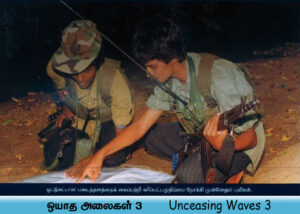
There is one thing to note here. The national leader Prabhakaran allowed the Sri Lankan army to capture 2533 sq km of Vanni territory through Rivipala, Ranakosa and Waterset operations but did not allow Poonakary to be captured.
Because a few months later, the national leader Prabhakaran knew that the Poonakary region was going to play a major role in the “Unceasing Waves 3” that he was about to launch.
Next Surprise
This may include the “Kudarappu Battle” led by General Balraj. This “Kudarappi Battle” is the biggest landing in the history of war in the world to date by a Non State Actor.
No one expected the LTTE to make such a dangerous battle.
Striking a foe in an unexpected manner can disorient him and ensure that his response comes too late to be effective.
The “Kudarappu Battle” is in complete agreement with the above statement.
So far, I have described how the “Unceasing Waves 3” of the LTTE (UW3 -P3, P4) had within itself the main characteristics of maneuver warfare.
Next Historical Minimum Planning Ratios
One particularly common heuristic is the utilization of force ratios, which express a numerical advantage deemed necessary to prevail in a localized area over the enemy. The most common force ratio is the 3: 1 rule, stipulating that success when attacking a prepared defensive position requires an offensive force with three times more troops than the defenders. A complete table of “Historical Minimum Planning Ratios” contained in current US Army doctrine is provided below.
The above section gives the U.S. Army’s war theory figures that emphasize the number of attacking forces that should be appropriate for each level of the enemy.
That is what the Historical Minimum Planning Ratios (Figure-6) illustrate.
According to the data in this table, if their position is prepared and fortified when the enemy takes defensive action, the attacking forces should be three times as many.
Based on the US Army’s Historical Minimum Planning Ratios, the LTTE must have had at least 51000-75000 fighters to attack and defeat the 17000-25000 Sri Lankan military’s prepared and fortified positions in the Elephant Pass.
However, with just under 7000 fighters, the 17000-25000 Sri Lankan army’s prepared and fortified Elephant Pass deployments were toppled.
Jeyakanth
(The rest is in the next section)
Click below for more articles
![]()
1. Oyatha Alaikal 03
012. Oyatha Alaikal 03 – Iranuva Aivu1
